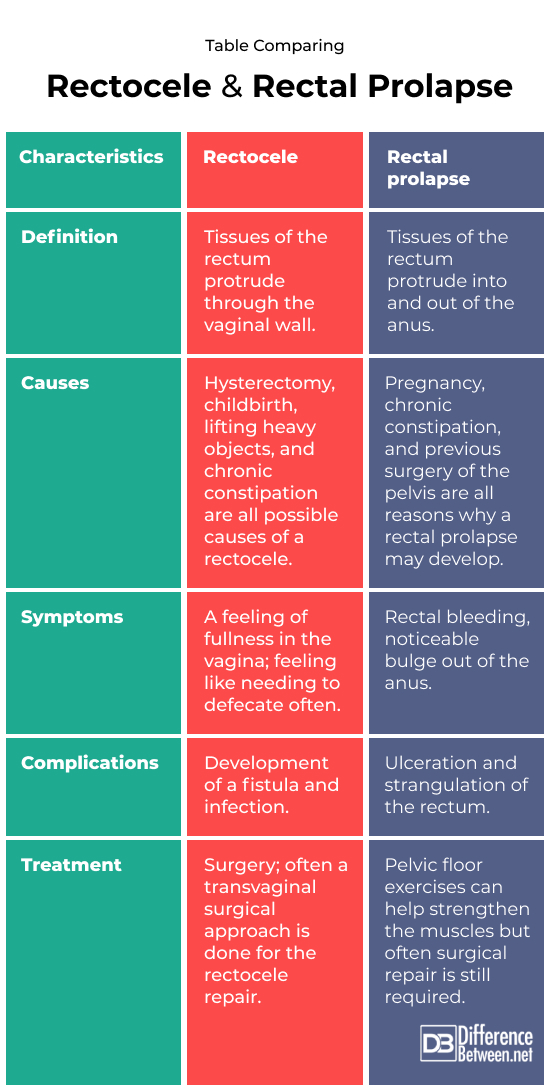Difference Between Rectocele and Rectal Prolapse
A rectocele is when rectal tissues extend into the vagina. A rectal prolapse is when rectal tissues extend out of the rectum and anus.

What is Rectocele?
Definition:
This is a problem where the tissues of the rectum protrude through the vaginal wall and extend into the vagina.
Causes and prevalence:
A rectocele happens when there is a weakening of the pelvic floor area. This weakened area can be due to pressure resulting from childbirth or due to a hysterectomy or lifting heavy objects. Chronic constipation can also add to the problem. A rectocele is most often found at birth or in people who are over 60 years of age.
Symptoms and complications:
Symptoms of a rectocele include a full feeling in the vagina and rectum. The tissue may protrude from the vagina. Feeling the need to defecate often is another symptom.
Diagnosis:
Diagnostic methods for a rectocele include a pelvic exam and imaging tests. A transvaginal ultrasound is often done to check for the prolapse if it is not obvious. A defecography, a type of imaging test can also be done. This checks how the muscles and structures function during defecation.
Treatment:
Treatment depends on how bad the problem is and may include placing a supporting device into the vagina or surgical repair of the rectocele. Pelvic floor exercises can help strengthen the tissues in mild cases.

What is Rectal prolapse?
Definition:
This is a problem where the tissues of the rectum protrude outside of the rectum through the anus. Sometimes the protrusion is only seen when the patient strains or walks.
Causes and prevalence:
Prolapse occurs when the muscles that hold the rectum in position become weak. It is often due to pregnancy, injury, surgery of the pelvis, childbirth, chronic constipation, nerve problems, or cystic fibrosis. It occurs most often in adult females over 50 but can happen in children with underlying conditions.
Symptoms and complications:
There is usually a protrusion from the anus and there may be some bleeding. Besides bleeding the rectum may ulcerate or become strangulated. A rectal prolapse can be dangerous if the tissue gets trapped and loses its blood supply. This can result in incarceration and necrosis.
Diagnosis:
Diagnosis includes a physical exam, sigmoidoscopy, and colonoscopy. These tests allow a doctor to evaluate any protruding tissue and also helps determine if the person has hemorrhoids or an actual prolapse of the rectum.
Treatment:
In adults, the treatment is surgery. In children, the doctors may strap the buttocks in between bowel movements.
Difference between Rectocele and Rectal prolapse?
Definition
A rectocele is when the rectal tissues extend through the wall of the vagina. A rectal prolapse is when rectal tissues protrude into the anal canal and out of the anus.
Causes
Hysterectomy, childbirth, lifting heavy objects, and chronic constipation are the causes of a rectocele. Pregnancy, chronic constipation, and previous surgery of the pelvis are causes of a rectal prolapse.
Symptoms
The signs of a rectocele include the following: a sensation of fullness in the vagina and feeling the need to defecate often. The signs of a rectal prolapse include the following: a bulge of tissue out of the anus and rectal bleeding.
Complications
The complications of a rectocele include the development of a fistula or infection. The complications of a rectal prolapse include strangulation and ulceration of the rectum.
Treatment
Surgery is often needed to fix a rectocele. Surgery is often also needed to repair a rectal prolapse.
Table comparing Rectocele and Rectal prolapse

Summary of Rectocele Vs. Rectal prolapse
- A rectocele and rectal prolapse both involve tissue extending out of the rectum.
- A rectocele only occurs in females while a rectal prolapse can occur in anybody.
- Surgical intervention is normally required to repair both conditions.
FAQ
Is rectal prolapse the same as rectocele?
No, a rectal prolapse is tissue protruding out of the anus from the rectum while a rectocele is tissue extending into the vagina through the vaginal wall.
Can you have a rectocele and a rectal prolapse?
Yes, a rectocele and rectal prolapse can sometimes both occur together at the same time in a woman. An internal prolapse of the rectum can also result in a rectocele.
What does a rectal prolapse look like?
At first the prolapse may look like hemorrhoids because it will be a round bulge hanging out of the anus.
Can you still poop with a rectal prolapse?
Often the person can still poop but it may be more difficult. It also depends on the size of the prolapse as to how difficult defecation may be.
What happens if you don’t fix a rectocele?
The rectocele can lead to worsening constipation or even incontinence if it is not fixed.
How do you rule out rectal prolapse?
Only a doctor can tell if you do or don’t have a rectal prolapse. They need to do a digital rectal exam to determine if you have a prolapse or some other issue that may mimic a prolapse (e.g. hemorrhoids).
- Difference Between Rumination and Regurgitation - June 13, 2024
- Difference Between Pyelectasis and Hydronephrosis - June 4, 2024
- Difference Between Cellulitis and Erysipelas - June 1, 2024
Search DifferenceBetween.net :
Leave a Response
References :
[0]Gourgiotis, Stavros, and Sotirios Baratsis. "Rectal prolapse." International journal of colorectal disease 22 (2007): 231-243.
[1]Kilpatrick. “Anterior and posterior vaginal wall prolapse (cystoceles, urethroceles, enteroceles, and rectoceles.” Merckmanuals. Merck & Co., 2022, https://www.msdmanuals.com/professional/gynecology-and-obstetrics/pelvic-organ-prolapse-pop/anterior-and-posterior-vaginal-wall-prolapse
[2]Parswi, Ansari. “Rectal prolapse and procidentia.” Merckmanuals. Merck & Co., 2022, https://www.msdmanuals.com/professional/gastrointestinal-disorders/anorectal-disorders/rectal-prolapse-and-procidentia
